A Comparison of Portable Infrared Spectrometers, Portable Raman Spectrometers, and Color-Based Field Tests for the On-Scene Analysis of Cocaine
Spectroscopy
On-scene analysis of cocaine is an essential tool for law enforcement. This study defines how portable infrared and Raman spectrometers are capable of providing accurate and reliable identification of cocaine and other drugs when and where needed most.
The majority of inmates in the United States are incarcerated for drug-related offenses. It is important that the technology used to test for controlled substances be accurate and reliable. For on-scene presumptive testing, color-based field tests are commonly employed. Numerous cases have been discovered where positive color-based field tests were later proven to be false positives via confirmatory laboratory testing. Portable infrared (IR) and Raman spectroscopy are capable of providing accurate and reliable identifications at the scene, but are not generally utilized for this purpose. This research evaluated important performance characteristics of these methods to determine which is best for conducting on-scene testing of cocaine HCl. This research concluded that although portable spectrometers require a large initial financial investment, their high performance characteristics (such as ease of use, rapid analysis, non-destructive capability, acceptable limit of detection, and minimal false positives and negatives) make them a superior tool to the color-based field tests for the on-scene presumptive analysis of cocaine HCl. Portable IR spectroscopy was determined to be better than portable Raman because of the lower limit of detection, less severe adulterant interferences, and Raman fluorescence of common drugs (such as heroin or additives).
A detailed online investigation into field-based presumptive tests for illicit drugs revealed many cases where false-positive color tests at the scene resulted in the incarceration of innocent people. The case of Amy Albritton was detailed in a New York Times Magazine article, and demonstrates the problem and its significance (1). A white "crumb" found in her vehicle was tested using the cobalt thiocyanate color test, and yielded a positive result for cocaine, although Albritton claimed innocence. Albritton was arrested, and pressured into taking a plea deal by her court-appointed defense lawyer, as he insisted that the test proved she was in possession of controlled substances and, thus, she would be better off taking the plea deal. She eventually complied, served her time in county jail, and went back to her life. It was not until months later that any confirmatory testing was done on the suspect crumb, and when it was conducted, it was concluded that the crumb was not a controlled substance. This, among other cases including those of Janet Lee (2), Antonia Carranza (3), and Karlos Casche (4), brings into question the reliability of color tests and indicates a need for finding superior methods for on-scene testing of controlled substances.
There is a significant need for field drug testing to be accurate and reliable. This is because, in drug possession cases, outcomes are often decided before they even reach a trial through the use of plea bargains to obtain a conviction. Many US Courts accept guilty pleas based solely on the results of field tests, such as those in nine of the ten jurisdictions of North Carolina, and the cities of Atlanta, Dallas, Jacksonville, Las Vegas, Los Angeles, Newark, Philadelphia, Phoenix, Salt Lake City, San Diego, Seattle, and Tampa. Research indicates that at least 90 % of drug convictions are obtained through plea deals, with some even higher (94 and 97% in Tennessee and Kansas, respectively) (1). Due to the significant errors (such as false positives and interferents) associated with color tests, portable vibrational spectroscopy, including IR and Raman methods, may provide a superior alternative for field testing of illicit substances, especially since these methods offer a higher level of confirmation of the illicit substance.
Portable IR and Raman spectrometers are both capable of identifying controlled substances, but have not seen widespread deployment by law enforcement for field testing, primarily because of the cost of the instrumentation. Another concern of the forensic science community is that nonscientist investigators would be executing scientific analyses at crime scenes, and may incorrectly conduct the test or misinterpret the results, or both. For field portable instrumentation to become a viable presumptive test for illicit drugs by law enforcement officers, the instruments need to not only be rugged, but simple to use by nonscientist personnel.
Recently, the National Institute of Justice (NIJ)'s Forensic Technology Center of Excellence (FTCoE) published a landscape study of portable and handheld instrumentation for presumptive drug testing in order to provide background information for law enforcement who are interested in these technologies (5). This study is an excellent resource for information, but the authors did not perform any specific laboratory or field research for comparisons of the various technologies, and instead relied on literature searches, manufacturer specifications, and interviews with current users. There was no ultimate conclusion of this landscape study, as it was determined that portable technologies provide general benefits (versatility, objectivity, specificity, safety, chain of custody collaboration, technical support, and ability to be used for multiple applications), and challenges (high up-front cost, complexity, maintenance, limited mixture interpretation, and library dependence), and each jurisdiction has its own needs and circumstances.
Experimental
Performance characteristics were assessed and compared for each technique: the Narcotics Identification Kit (NIK) Test G for cocaine produced by Safariland, a Smiths Detection HazMatID Elite portable IR spectrometer with a diamond attenuated total reflection (ATR) sampling element, and a Smiths Detection ACE-ID portable Raman spectrometer. These instruments were used due to their availability, but the research could be applied to any company's comparable portable instrumentation.
The specific performance characteristics that were evaluated for all methods included a limit-of-detection study, an investigation into specificity (potential false positives, false negatives, and adulterant interactions), and evaluation of the ease of use, speed of analysis, skill required of the operator, and destructive nature of the method.
Two-component mixtures were created by using pure cocaine HCl (Sigma-Aldrich) as well as the following five adulterants: lidocaine, mannitol, caffeine, Sweet 'N Low artificial sweetener, and Enfragrow powdered baby formula. Samples with concentrations of 0.1, 0.5, 1, 5, 10, 25, and 50% by mass of cocaine HCl were prepared for experimentation. When portable IR and Raman analyses were conducted, samples of 35% and 15% were subsequently made to obtain more precise limits of detection.
Figure 1: Color-based field test results showing a positive result with 25% cocaine HCl in lidocaine (left) and a negative control (right).
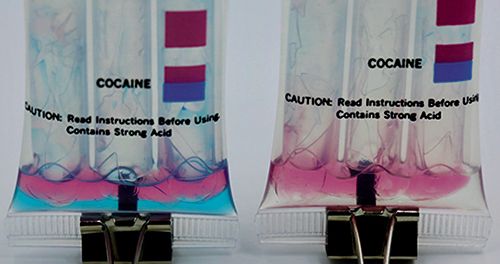
A positive result for cocaine HCl with the NIK test, as shown in the left side of Figure 1, was indicated by "blue or pink with blue speckles after breaking the first ampoule, a pink result after breaking the second ampoule and a pink layer over a blue layer after breaking the third ampoule (6)." If the proper color change did not occur (right side of Figure 1), this was noted as a negative result. A positive result for cocaine HCl with the portable IR and Raman instruments was indicated by a "hit" for cocaine HCl using the library search function on the instrument (Figures 2 and 4, respectively). If a "hit" was not provided, this was noted as a negative result.
Figure 2: Screen readout after a mixture of 25% cocaine HCl in lidocaine was analyzed, with the portable IR spectrometer showing (a) the component list and (b) the spectrum for cocaine HCl.
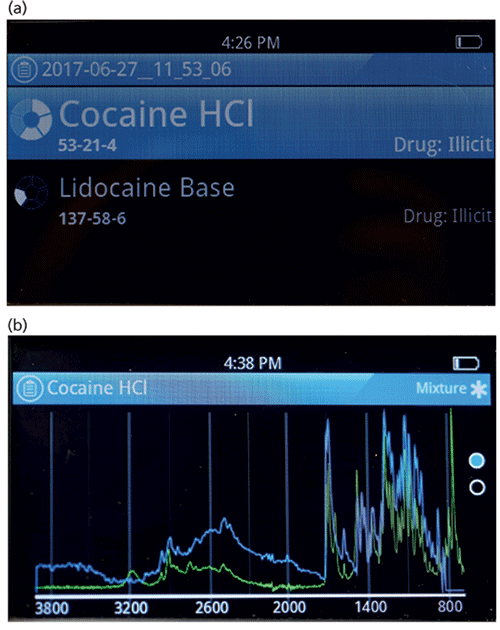
Results and Discussion
Color-Based Field Testing
Before experimentation, pure samples of cocaine HCl, as well as each adulterant, were analyzed to establish controls, as well as ensure the adulterants were not false positives for cocaine HCl. It was found that lidocaine was a false positive for cocaine HCl with the color-based field test. Therefore, only the sample sets containing the other four adulterants were used for color testing experimentation.
The limit of detection determined for the color-based field test was at a 10% concentration of cocaine HCl with all four adulterants tested. Sources have conflicting reports on the average purity of cocaine HCl found in street samples. In 2016, it was reported by the Colombian National Police that the purity of cocaine leaving their country was approximately 85%, but by the time the cocaine reached the UK, the purity was approximately 60% and dropped to about 30% at the retail level (7). The US Department of Justice released an article in February 2010 indicating that from 2006 to 2009, cocaine purity had decreased from 68.1% to 46.2%. Even if the lowest reported concentration of 30% were used as a reference, this would make the limit of detection for the color-based field test acceptable.
An extensive literature review revealed numerous known substances that would provide a positive result with the cobalt thiocyanate test other than cocaine HCl (Table I), which is the basis for the color-based field test for cocaine. One article from the Journal of Forensic Sciences listed 73 different compounds, indicating a large quantity of potential false positive results with the test (8).

The color-based field test is a destructive method that prevents any further experimentation from being conducted on the sample used. It is simple to use, with directions provided in each box. The color changes are very obvious at high concentrations of cocaine HCl; however, at lower concentrations it can be difficult to discern the color of the bottom layer. The subjectivity of determining a positive result is a problem when there is ambiguity at low concentrations. This method would also not be viable for operators with a color-determination deficiency. A single analysis is fast, taking only a few minutes, and there is little adulterant interaction that affects the limit of detection. However, one sample may require several different tests to identify the illicit drug, thus taking more time than just a single analysis. Additionally, this test requires sampling of the specimen for testing, thus potentially exposing the user to an unknown substance. There is also no reproducible record of the testing, and the color results may degrade over time, although detailed documentation with photography is a possibility.
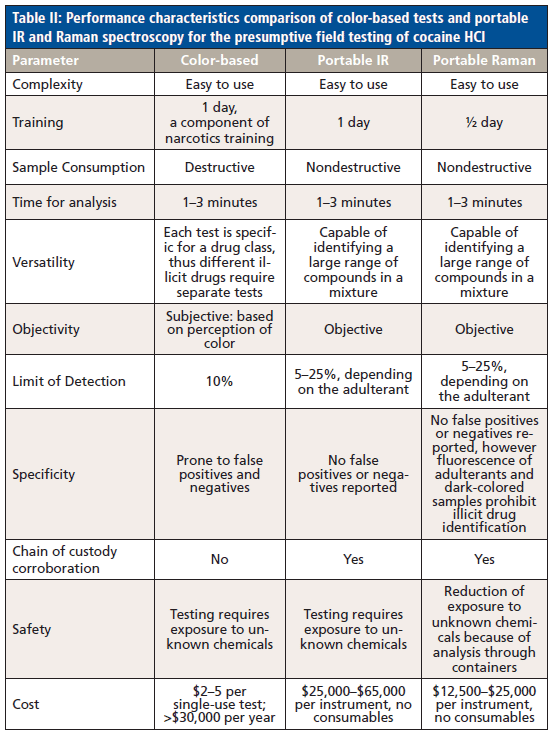
The cost for the color-based field test for cocaine, crack, and free base is $25.50 for a box of ten tests. Other commercially available color tests cost between $2 and 5 dollars per test (5). As these tests are one-use only, whomever is employing the tests must buy a large quantity each year. The NIJ's landscape study estimated that a large metropolitan area has approximately 500 drug-related arrests per year, with two color tests being used for each arrest, resulting in a total cost of $30,000 per year. However, this does not take into account the number of cases where no arrest was made, due to a negative results with the color test. Further, the tests are only specific to a particular drug "group," so law enforcement personnel require separate color-based field tests for cocaine HCl than for marijuana, PCP, or opiates. These tests do have expiration dates, and cannot be stored indefinitely. Consequently, the $30,000 per year calculation is likely an underestimate of the actual cost. The perceived low cost of these tests is considered by law enforcement to be a significant benefit over portable instrumentation.
Another factor is the potential litigation fees that could arise from someone who has been falsely convicted of drug possession. A person could file a civil suit, and those litigation fees could far outweigh the cost of investing in a more reliable method of presumptive testing at crime scenes. This does not include the non-monetary costs that come along with being falsely charged with drug possession due to a faulty test result, causing considerable personal distress.
Portable IR Spectroscopy
The limit of detection for portable IR using the on-board library search algorithm for mannitol, caffeine, and baby formula were at 25%. Below 25%, the instrument did not provide positive "hits" for cocaine HCl. For artificial sweetener, the instrument was able to detect cocaine HCl at 15%, and, for lidocaine, it consistently had limits of detection at 5%. When manual spectral analysis was conducted by an educated chemist in spectral interpretation, cocaine HCl was identified in all of the spectra below the established limit of detection for the instrument's search algorithm (Figure 3). This instrument provides a Reachback feature, where the user can electronically send a spectrum to a trained spectral interpreter for technical support at any time and day. This indicates that, even if the instrument does not provide a positive "hit," the user can receive technical support to assist with interpretation and troubleshooting. The spectra could also be sent to a forensic laboratory for interpretation, depending on the agency's protocols. Additionally, as previously mentioned, the lowest concentration of street cocaine HCl was reported to be 30%, which is higher than the limit of detection for the portable IR with all adulterants tested.
Figure 3: Spectra of 15% cocaine HCl in baby formula (blue) below the limit of detection for the instrument's library search algorithm, but containing characteristic peaks for cocaine (red) identified by manual spectral analysis.
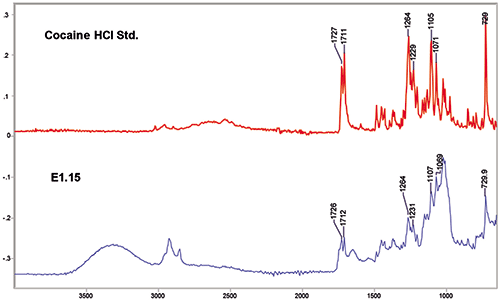
There were no false positives or negatives identified with the portable IR spectrometer; however, there were a number of misidentifications found with the portable IR spectrometer. A misidentification is any substance identified by the instrument that was wrongly identified in place of an authentic mixture component. There were also false identifications made in which an extra component was identified in addition to the known components that were not actually present in the mixture (called a "false hit"). Mistaken identifications are potentially a large point of concern, but only if these incorrectly identify or prevent the identification of a controlled substance. In this research, the majority of these false hits were extra identifications that were determined to be of innocuous substances. Ultimately, as long as the cocaine HCl is still being identified, an extra hit for something because of the adulterant being used does not necessarily affect the test results.
Figure 4: Screen readout after a mixture of 25% cocaine HCl in lidocaine was analyzed with the portable Raman spectrometer, showing (a) the component list and (b) the spectrum for cocaine HCl.
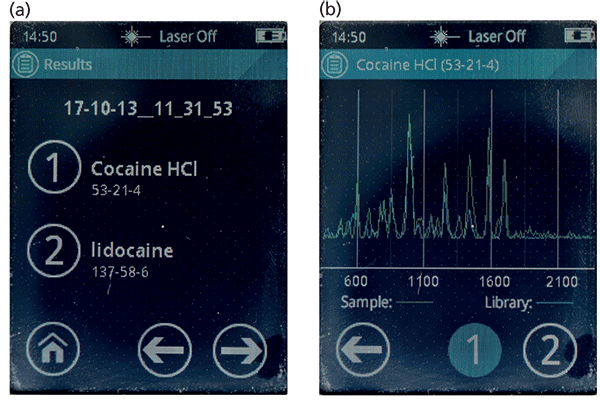
IR spectroscopy is a nondestructive method. Portable IR instruments are simple to operate. Step-by-step prompts with icons are shown throughout an analysis. Although these instrument are easy to use and can be operated with little training, scientific knowledge is required for sample selection, evaluating the spectral quality, and trouble shooting. A large benefit over the color tests is the chain of custody corroboration in that when a sample is tested, the results are automatically stored and time-stamped in the instrument to be exported or reviewed later. Similar to the color tests, portable IR with ATR sampling requires direct testing of the specimen, thus potentially exposing the user to an unknown substance.
Formal training would be required for the operation of a portable IR spectrometer. However, it is simple to operate, so the training could easily be incorporated into that already provided for officers. The analysis overall does not take more than a few minutes for each sample being run, which is comparable to the speed of the color-based field test.
Though prices on portable IR spectrometers vary by company, model, and add-ons (such as libraries, attachments, and service), the price can range from $25,000 to $65,000. There are no consumables required for portable IR spectrometers, so this is a one-time, up-front cost. Additionally, these instruments are built to be rugged and used in high stress situations; this means that, though repair on the instruments may be necessary, they will not break easily and could be used for several years. Also, portable spectrometers have the capability to identify a large number of controlled substances. Instead of buying ten different color-based field tests and making sure a police department is stocked for an entire year with all of these options, one portable spectrometer could conduct the same analysis. Finally, an increased demand for these instruments would encourage companies to increase production, which could lead to a cost reduction, thus making it a more affordable technology.
Portable Raman Spectroscopy
The limit of detection for the portable Raman spectrometer using the on-board library search algorithm was consistently 25% cocaine HCl for all adulterants. In most trials, the instrument could not detect cocaine HCl at lower percentages; however, it was able to detect as low as 5% with the artificial sweetener, and 10% with the baby formula. The ability to electronically send spectra to Reachback or to a forensic laboratory for manual spectral interpretation is also available for portable Raman spectrometers. However, for these samples, manual Raman spectral analysis did not enable lower detection limits.
One of the advantages of Raman spectroscopy is the ability to analyze samples without making contact, analyzing through some containers made of clear glass and plastic bags. The ability to analyze substances contained within clear plastic bags was tested, and the limit of detection was unaffected, remaining at 25%. This limit of detection would be acceptable to detect the lowest reported concentration of cocaine HCl in street samples. Consequently, unlike color tests and portable IR spectroscopy, portable Raman does not require direct testing, thus reducing exposure to unknown substances.
There were no false positives or negatives identified with the portable Raman spectrometer. As with the portable IR spectrometer, there were a number of "false hits" and misidentifications that occurred during analysis. The portable Raman analysis had significantly fewer misidentifications and false hits than the portable IR, with a likely explanation being the smaller onboard Raman spectral library, which limits misidentifications and false hits. Although none of the adulterants tested suffered from Raman fluorescence, it is important to recognize that other illicit substances (such as heroin) or adulterants may fluoresce, which would interfere with the ability for chemical identification of any of the mixture components. Dark-colored samples prohibit Raman analysis because they absorb the incident radiation, thus potentially destructively burning the sample. In this situation, an orbital-raster-scanning (ORS) Raman was used to minimize the transfer of incident radiation, but not all portable Raman systems use ORS Raman. These issues may prohibit Raman analysis for the identification of cocaine or other illicit drugs in the field.
Similar to IR spectroscopy, Raman spectroscopy is nondestructive, requires only a few minutes for analysis, and creates a reviewable record of the analysis that provides chain-of-custody corroboration. Much like the portable IR spectrometer, it is a push-button method, with step-by-step instructions on the screen. However, there is a small spot size for analysis, and focusing the LASER can be challenging at times. Sometimes, a few attempts are necessary to get a viable spectrum of the sample. As with the portable IR spectrometer, formal training would be required for the operation of the portable Raman, which could be simply incorporated into general training that officers are given. The same caveat applies for both portable spectrometers: Despite their ease of use, there is a need for educated users for proper sampling and analysis.
Portable Raman spectrometers are generally less expensive than most portable IR spectrometers, although there are some exceptions; thus prices range from $12,500 to $60,000. Similarly to IR spectrometers, these instruments are built to be rugged and do not require consumables, so this is a one-time, up-front cost.
Conclusions
Portable spectrometers have excellent potential to be employed for the on-scene analysis of cocaine HCl. Performance characteristics were compared (Table II), and the advantages of portable spectroscopy over traditional color testing were demonstrated. The limit of detection for all three methods would be acceptable at the lowest reported purity of street cocaine HCl. The speed of analysis is comparable for all three methods, taking less than 3 min for each analysis. Portable IR and Raman spectroscopy methods are nondestructive, objective, and create a reviewable record for use as evidence in adjudications, which are significant advantages over color tests. Color tests are also more prone to false positives and negatives than tests using portable spectroscopy, thus the latter are more reliable for the on-scene analysis of cocaine HCl. Portable Raman also has the ability to identify cocaine HCl through some plastic bags, reducing the potential for contamination and risk of exposure to unknown chemicals by analysts. Color tests require less knowledge or skill from the operator, however, inserting training on the different spectrometers during general training for officers would be simple and feasible because the instruments are created to be user-friendly. Although color tests are generally thought to be less expensive than portable spectrometers, the total cost over several years is comparable, if not greater than, an instrument with only a one-time up-front cost.
Of the two portable spectroscopic methods, the authors concluded that, although both technologies have similar performance characteristics, there are some features of portable IR spectroscopy that make it the preferred technique for on-scene cocaine HCl identification. The long and reputable history of IR spectroscopy means that there are more spectral libraries and the technology has had more time to be evaluated and perfected. Additionally, fluorescence and the inability to analyze dark samples lessens the utility of the portable Raman spectrometers, whereas a portable IR spectrometer is able to produce interpretable spectra for all specimens. Although these limitations were not a problem in the specific analyses tested in this research, they could prove to be prohibitive for identification by portable Raman of cocaine mixed with other adulterants and for the analysis of other drugs, like heroin. Portable Raman spectrometers have the advantages of being generally less expensive than portable IR spectrometers, as well as being able to analyze samples through some clear glass and plastics, thus providing greater safety for the analyst. Ultimately, both portable IR and Raman spectroscopy are viable alternatives for crime scene identification of cocaine HCl.
References:
(1) R. Gabrielson and T. Sanders, "How a $2 Roadside Drug Test Sends Innocent People to Jail" (July 7, 2016). Retrieved April 28, 2018, from https://www.nytimes.com/2016/07/10/magazine/how-a-2-roadside-drug-test-sends-innocent-people-to-jail.html.
(2) J. Kelly, "False Positives Equal False Justice" (2008). Retrieved April 28, 2018, from https://www.mpp.org/issues/criminal-justice/false-positives/.
(3) E. Peralta, "Thinking It Was Cocaine, N.C. Police Jail Man For Cheese And Tortilla Dough" (May 16, 2011). Retrieved April 28, 2018, from https://www.npr.org/sections/thetwo-way/2011/05/16/136359770/thinking-it-was-cocaine-n-c-police-jail-man-for-cheese-and-tortilla-dough?ft=1&f=1001&sc=tw&utm_source=twitterfeed&utm_medium=twitter.
(4) S. Jeong, "Man Spends Three Months In Jail After False Positive On Police Drug Test" (June 28, 2017). Retrieved April 28, 2018, from https://www.cnn.com/2017/06/28/us/drug-test-drywall-positive-arrest-trnd/index.html.
(5) Forensic Technology Center of Excellence. Landscape Study of Field Portable Devices for Chemical and Presumptive Drug Testing. U.S. Department of Justice, National Institute of Justice, Office of Investigative and Forensic Sciences (2018).
(6) Safariland Group. NIK Test G- Cocaine, Crack, & Free Base (2018). Retrieved August 29, 2018, from http://www.safariland.com/products/forensics/field-drug-tests/nik-test-g---cocaine-crack-and-free-base-1006155.html#sm0000624lqmakerfrm2cnczoduu2.
(7) United Nations Office on Drugs and Crime. World Drug Report 2012. United Nations Publication, New York (2018).
(8) S. Johns, A. Wist, and A. Najam, J. Forensic Sci. 24(3), 631-649 (1979).
Dory Lieblein, Peter Massey, and Brooke W. Kammrath are with the Henry C. Lee College of Criminal Justice and Forensic Sciences at the University of New Haven, in West Haven, Connecticut. Meghann E. McMahon is with the Wisconsin State Crime Laboratory, in Milwaukee, Wisconsin. Pauline E. Leary is with Smiths Detection, in Edgewood, Maryland. Direct correspondence to: bkammrath@newhaven.edu.

Geographical Traceability of Millet by Mid-Infrared Spectroscopy and Feature Extraction
February 13th 2025The study developed an effective mid-infrared spectroscopic identification model, combining principal component analysis (PCA) and support vector machine (SVM), to accurately determine the geographical origin of five types of millet with a recognition accuracy of up to 99.2% for the training set and 98.3% for the prediction set.
Authenticity Identification of Panax notoginseng by Terahertz Spectroscopy Combined with LS-SVM
In this article, it is explored whether THz-TDS combined with LS-SVM can be used to effectively identify the authenticity of Panax notoginseng, a traditional Chinese medicine.